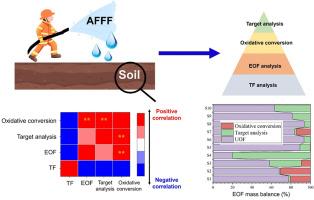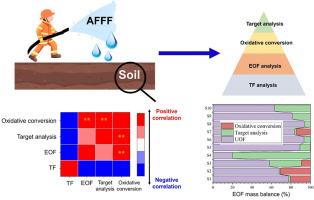What we learn from using mass balance approach and oxidative conversion – A case study on PFAS contaminated soil samples
IF 7.3
2区 环境科学与生态学
Q1 ENVIRONMENTAL SCIENCES
引用次数: 0
Abstract
Per- and polyfluoroalkyl substances (PFAS) are a large family of synthetic fluorinated chemicals. Studies using multiple analytical approaches to evaluate PFAS-contaminated soils are still limited, potentially leading to an underestimation of PFAS pollution. This study introduced a stepwise analytical workflow for a comprehensive assessment of organofluorine, integrating total fluorine (TF) determination, extractable organofluorine (EOF) analysis, PFAS target analysis, and PFAS precursor oxidative conversion assay. The workflow was applied to ten field soil samples collected from aqueous film-forming foam (AFFF)-contaminated sites. The sum target PFAS concentration (∑PFAS) ranged from 51.8 to 23200 ng/g dry weight. Perfluorooctanesulfonic acid was the predominant PFAS, accounting for 13 %–82 % (mean value: 53 %) of the ∑PFAS. Target PFAS accounted for 1 %–80 % of the EOF in the soil samples, and the integration of oxidative conversion revealed additional EOF contributions ranging from 0 % to 31 %. However, a considerable proportion (20 %–94 %) of unknown organofluorine still persists after combining targeted PFAS analysis and oxidative conversion, likely due to non-oxidizable PFAS, incomplete conversion of unknown PFAS precursors, and persistence of ultra-short chain PFAS post oxidative conversion. In addition, a significant positive correlation was observed between oxidative conversion and EOF results, but not with PFAS target analysis, suggesting that oxidative conversion may better represent the organofluorine burden in AFFF-impacted soils. Our findings indicate that TF analysis is unsuitable for tracing PFAS contamination in soils. Instead, combining oxidative conversion with routine PFAS target analysis is recommended to comprehensively assess PFAS contamination in soils.


我们从质量平衡法和氧化转化中学到的东西——以PFAS污染土壤样品为例
全氟和多氟烷基物质(PFAS)是一大类合成氟化化学品。使用多种分析方法评估PFAS污染土壤的研究仍然有限,可能导致PFAS污染的低估。本研究引入了一种综合评估有机氟的分步分析流程,包括总氟(TF)测定、可提取有机氟(EOF)分析、PFAS靶分析和PFAS前体氧化转化分析。该工作流程应用于从水成膜泡沫(AFFF)污染地点收集的10个现场土壤样品。总目标PFAS浓度(∑PFAS)为51.8 ~ 232000 ng/g干重。全氟辛烷磺酸是主要的PFAS,占∑PFAS的13% ~ 82%(平均值53%)。目标PFAS占土壤样品中EOF的1%至80%,氧化转化的整合显示额外的EOF贡献在0%至31%之间。然而,结合靶向PFAS分析和氧化转化后,仍然存在相当比例(20% ~ 94%)的未知有机氟(UOF),这可能是由于PFAS不可氧化、未知PFAS前体转化不完全以及氧化转化后超短链PFAS的持续存在。此外,氧化转化与EOF结果呈显著正相关,但与PFAS目标分析无关,这表明氧化转化可能更能代表afff影响下土壤的有机氟负荷。我们的研究结果表明,TF分析不适合追踪土壤中PFAS的污染。建议将氧化转化与常规PFAS靶分析相结合,综合评价土壤中PFAS的污染状况。
本文章由计算机程序翻译,如有差异,请以英文原文为准。
求助全文
约1分钟内获得全文
求助全文
来源期刊

Environmental Pollution
环境科学-环境科学
CiteScore
16.00
自引率
6.70%
发文量
2082
审稿时长
2.9 months
期刊介绍:
Environmental Pollution is an international peer-reviewed journal that publishes high-quality research papers and review articles covering all aspects of environmental pollution and its impacts on ecosystems and human health.
Subject areas include, but are not limited to:
• Sources and occurrences of pollutants that are clearly defined and measured in environmental compartments, food and food-related items, and human bodies;
• Interlinks between contaminant exposure and biological, ecological, and human health effects, including those of climate change;
• Contaminants of emerging concerns (including but not limited to antibiotic resistant microorganisms or genes, microplastics/nanoplastics, electronic wastes, light, and noise) and/or their biological, ecological, or human health effects;
• Laboratory and field studies on the remediation/mitigation of environmental pollution via new techniques and with clear links to biological, ecological, or human health effects;
• Modeling of pollution processes, patterns, or trends that is of clear environmental and/or human health interest;
• New techniques that measure and examine environmental occurrences, transport, behavior, and effects of pollutants within the environment or the laboratory, provided that they can be clearly used to address problems within regional or global environmental compartments.
 求助内容:
求助内容: 应助结果提醒方式:
应助结果提醒方式:


